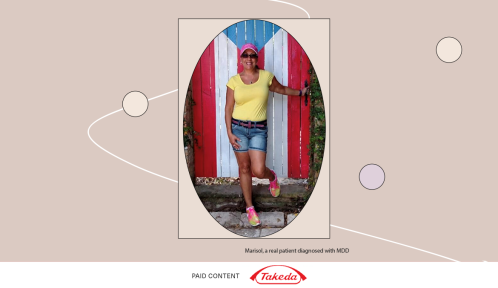Our editors independently select these products. Making a purchase through our links may earn Well+Good a commission
What Comes After the Process of Grief?
Author Hope Edelman says it's time to retire the old model of grief, explaining that grief isn't a five-stage process and that's okay.

Denial, anger, bargaining, depression, acceptance. You’ll likely recognize these five words in succession as the five stages of grief, a psychology model that outlines the way in which we can expect to cope—and heal—upon experiencing loss. But what if we’ve had it wrong all this time—and what if that’s actually a good thing?
Experts in This Article
Hope Edelman has been writing, speaking, and leading workshops and retreats in the bereavement field for more than 25 years. Hope’s first book, Motherless Daughters, was a #1 New York Times bestseller and Hope’s most recent book, The AfterGrief, offers an innovative new language for discussing the long arc of loss.
It’s exactly the point author and grief coach Hope Edelman is trying to make in her recently released title The AfterGrief ($16), a book exploring the long arc of loss. “When Dr. Elisabeth Kübler-Ross introduced these five stages in the 1960s, it was for terminally ill patients, and they were called the ‘five stages of dying,’” says Edelman, who notes how those stages, in that regard, made a lot of sense—how one could understandably move from denial and anger about a diagnosis to bargaining for change to eventual acceptance of their prognosis. The problem came, she notes, when those five stages were transferred onto mourners, becoming mistakenly known then as the “five stages of grief.” “It was such a seductive idea to the culture at the time that grief was something that we could work our way through and be done with,” she says. “The media took it and ran with it.”
And for some time, for some people, that narrative seems to pan out okay. Until, that is, any or all of these stages resurface—and those who thought they had finished the grieving process figure they must have gotten something wrong.
“Now, all of the time you hear people saying, ‘I think I’m stuck in the denial phase,’ or ‘I can’t get past the anger phase,’ when, in fact, grief doesn’t work like that,” says Edelman. We can feel all of those emotions—out of order or all at once—and, as so many are realizing, over the course of a lifetime. “Grief doesn’t happen in these neat and tidy silos because it isn’t linear—it’s cyclical,” she says.
It’s exactly why Edelman set out to write The AfterGrief, for which she interviewed 82 individuals, most of whom spoke about their early life losses and the years that followed. She reviewed these accounts alongside interviews with grief experts and data from a series of studies, all with the hopes of creating a model for long-term bereavement—one that extended beyond the previously accepted “five stages.” “I became aware from my own experience and through my research that what we were calling ‘acceptance’ was not an endpoint at all, but a way station that we would depart from and return to many times over the course of a lifetime,” she says.
Edelman lost her own mother at the age of 17, an event that led her to write Motherless Daughters ($16) and Motherless Mothers ($14), books exploring the mother-daughter connection and impact of significant loss (the former of which has been translated into 11 languages and sold more than 1 million copies worldwide).
“The AfterGrief was published 27 years after the release of Motherless Daughters, and throughout that time, I had been looking for some kind of model for long-term bereavement that would explain the ways in which grief continues to show up 10, 20, 30 years later—and there weren’t any that spoke to me,” she says. “Having lost my mother in my teens, I knew by now that this clearly wasn’t something I was getting over or getting past or putting down. It was something that I was carrying forward with me.”
Appropriately, the introduction to The AfterGrief is titled “Getting Over Getting Over It,” an immediate reassurance to those who have inevitably experienced the ways in which grief, in all of its twists and turns, can resurface over the years. There are the more expected “grief spikes,” as Edelman writes, times in which grief can return for events like birthdays and anniversaries, or milestones, such as weddings, graduations, or having children of one’s own. And then, there are the “sneak attacks,” a term Edelman adopted from Rebecca Soffer of grief website Modern Loss, describing the moments in which grief reveals itself quickly and unexpectedly. Edelman outlines her own on the first page of her book, detailing a recent experience she had while driving when “The Weight” by The Band started playing. When the refrain’s piano chords kicked in, Edelman was kicked right back to her childhood living room, where she would watch her mother, a classically trained pianist, maneuver the keys with perfectly painted red nails.
“I think of grief more as a constant renegotiation with the facts of a loss and our relationship to those facts—and that changes over time.”
“This kind of grief doesn’t typically last for long, but it can make some feel that they didn’t do it right or that their grief is unresolved,” says Edelman, pointing out that she never did agree with describing grief in such terms. “I think of grief more as a constant renegotiation with the facts of a loss and our relationship to those facts—and that changes over time.” For many, that’s where things can start to feel uncomfortable—when the story we’ve grown so accustomed to is now changing a few years, or a few decades, later. But that change, Edelman reassures us, is a good thing. “If we are growing and maturing and developing our perception of events in the past, then our perspectives are going to change, too.”
As such, Edelman closes out the book with a section on the act of “reframing,” the ways in which we can choose to create meaning around our circumstances. She references a recent interview she saw between Anderson Cooper and Stephen Colbert—both of whom were just 10 years old when their fathers died (and, for Colbert, two brothers, as well)—when Colbert exemplifies this practice, speaking to the importance of loving the things in life we most wish had not happened.
“I think of reframing really as a deliberate or willful shift in perspective—we make a choice that we want our perspective to change,” says Edelman, noting just one way to do this is to acknowledge that while something sad and tragic may have happened to us in losing a loved one, that good things can still come from it. “We may not have had any choice in what happened when someone died—we may have felt really powerless and out of control—but as we carry that loss forward, we do have a lot of choice about how we’re going to do that,” she says. Done accordingly, those who have suffered trauma or tragedy can use those experiences as segues to growth and personal development.
And, Edelman says, as a catalyst for change that extends beyond us, as well: “We can better the world.”
Oh hi! You look like someone who loves free workouts, discounts for cult-fave wellness brands, and exclusive Well+Good content. Sign up for Well+, our online community of wellness insiders, and unlock your rewards instantly.
Sign Up for Our Daily Newsletter
Get all the latest in wellness, trends, food, fitness, beauty, and more delivered right to your inbox.
Got it, you've been added to our email list.










